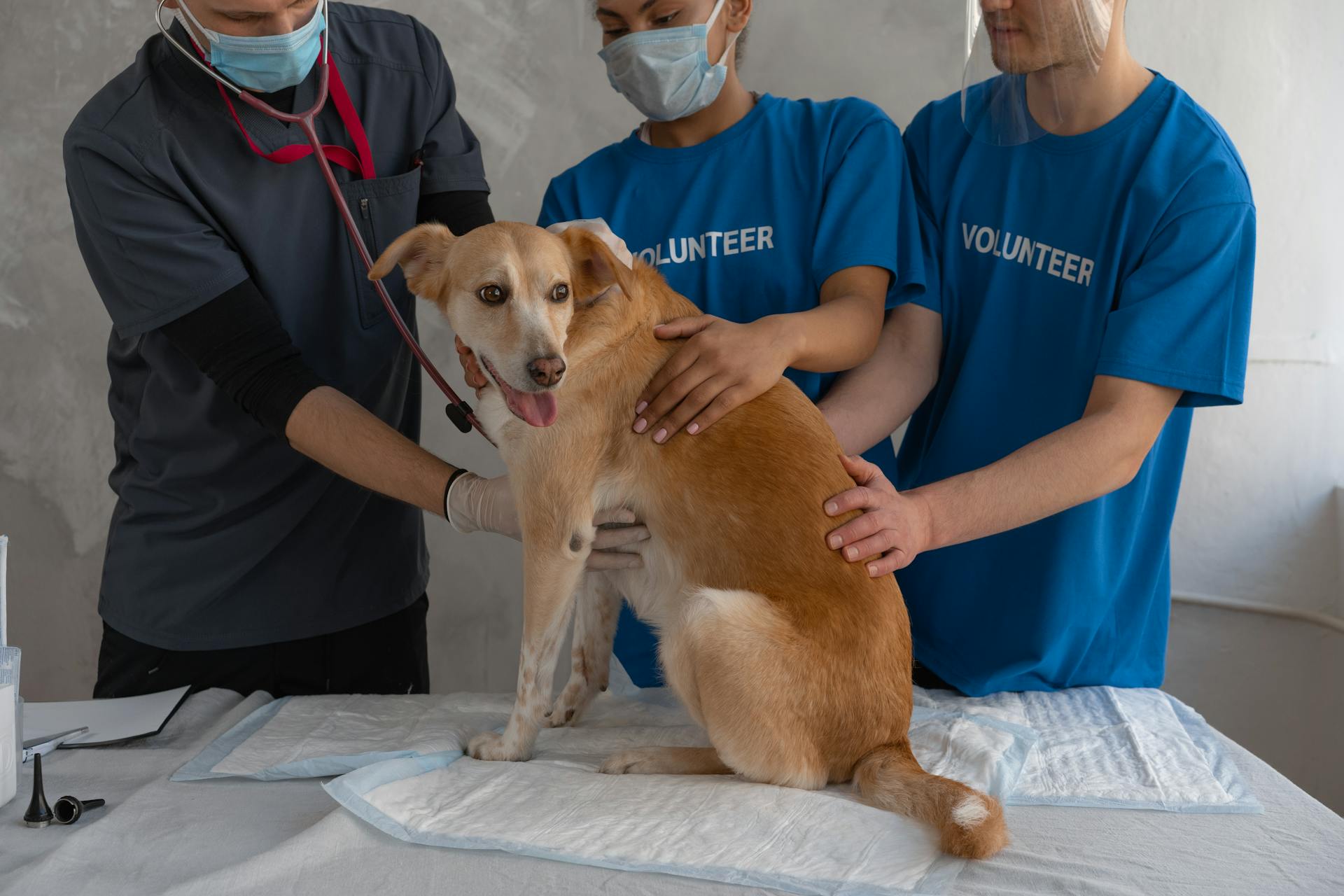
Canine distemper is a serious and highly contagious disease that affects dogs of all ages, but it's most common in puppies under 6 months old.
The incubation period of canine distemper is typically 7-14 days, but it can range from 4-21 days.
Symptoms of canine distemper can vary depending on the stage of the disease, but they often start with a mild fever and progress to more severe symptoms.
In the early stages of canine distemper, dogs may exhibit a runny nose, watery eyes, and a cough, which can be mistaken for kennel cough.
Explore further: Canine Vector-borne Disease
What is Canine Distemper
Canine distemper is a serious viral disease that affects dogs. The virus is shed in bodily fluids of infected animals and primarily targets the lungs, intestines, and nervous system.
Symptoms of the infection can include coughing, diarrhea, vomiting, inappetance, dehydration, weight loss, seizures, and encephalitis. Secondary infections can also occur, leading to discharge from the eyes and/or nose, and pneumonia.
Puppies, especially those from shelters, are at the highest risk of contracting canine distemper. Currently, there are no antiviral medications to treat the disease.
Treatment for canine distemper focuses on controlling secondary bacterial infections with antibiotics and providing supportive care as needed.
Take a look at this: Canine Lupus
Causes and Symptoms
Canine distemper is a serious disease that affects dogs. It's caused by a virus that's shed in bodily fluids of infected animals.
The virus primarily affects the lungs, intestines, and nervous system. Symptoms can include coughing, diarrhea, vomiting, inappetance, dehydration, weight loss, seizures, and encephalitis.
Some dogs may only show minor symptoms like eye and nasal discharge, while others may have no symptoms at all. However, as the disease progresses, dogs can develop more severe symptoms like tremors, chewing motions of the jaw, seizures, and partial or complete paralysis.
Dogs can contract distemper through respiratory secretions, such as coughing and sneezing, as well as through contact with infected animals or contaminated surfaces and equipment.
Here's a list of common symptoms of distemper in dogs:
- Yellow or green eye discharge
- Nasal discharge
- Coughing
- Sneezing
- Depression
- Vomiting
- Decreased appetite
- Diarrhea
- Tremors
- Chewing motions of the jaw
- Seizures
- Partial or complete paralysis
- Pneumonia
- Crusting of the nose and foot pads
- Severe vomiting and diarrhea
Symptoms
Symptoms can be quite varied, but they often start with eye and nasal discharge, which can be yellow or green. This can be a sign of a minor cold, but in dogs with distemper, it's a warning sign.

Coughing and sneezing are also common early symptoms, which can be accompanied by depression, vomiting, and decreased appetite. Diarrhea is another symptom that can appear early on.
As the disease progresses, dogs can develop tremors, chewing motions of the jaw, and seizures. Some dogs may even experience partial or complete paralysis, pneumonia, crusting of the nose and foot pads, and severe vomiting and diarrhea.
Here are some of the common symptoms of distemper in dogs:
- Yellow or green eye discharge
- Nasal discharge
- Coughing
- Sneezing
- Depression
- Vomiting
- Decreased appetite
- Diarrhea
- Tremors
- Chewing motions of the jaw
- Seizures
- Partial or complete paralysis
- Pneumonia
- Crusting of the nose and foot pads
- Severe vomiting and diarrhea
Causes
Distemper is primarily spread through respiratory secretions like coughing and sneezing, as well as other bodily fluids like urine, vomit, and stool.
Contact with an infected animal is the most common way for distemper to spread, but shared food bowls and contaminated supplies, surfaces, and equipment can also pose a risk.
Dogs, ferrets, and wildlife can appear healthy and still be a source of the distemper virus.
Recovered dogs may remain contagious for several months.
Ferrets are also at risk for being infected with the canine distemper virus and should be vaccinated against it.
Intriguing read: Canine Distemper Side Effects
Clinical Presentation
Canine distemper can manifest in a wide range of clinical presentations, from mild to severe. Commonly observed signs include a runny nose, vomiting and diarrhea, dehydration, excessive salivation, coughing and/or labored breathing, loss of appetite, and weight loss.
The severity and progression of the disease can vary greatly, with some dogs experiencing a short course of illness lasting only 10 days, while others may develop neurological signs that can take weeks or months to appear. In dogs that survive the acute phase, hyperkeratosis of the footpads and epithelium of the nasal planum may occur, as well as enamel hypoplasia in incompletely erupted teeth.
Typical neurologic signs include localized involuntary muscle twitching, seizures, and chewing movements of the jaw. Other neurologic signs include circling, head tilt, nystagmus, paresis to paralysis, and seizures ranging in type from focal to generalized.
A unique perspective: Canine Vision Loss
Clinical Signs
Clinical signs of canine distemper can vary widely, from no signs to severe pneumonia with vomiting, bloody diarrhea, and death.
A unique perspective: What Are Signs of Allergies in Dogs

Dogs may exhibit a runny nose, vomiting and diarrhea, dehydration, excessive salivation, coughing and/or labored breathing, loss of appetite, and weight loss.
The condition can progress to neurological signs, including incontinence, localized involuntary twitching of muscles or groups of muscles, seizures with salivation, and jaw movements commonly described as "chewing-gum fits."
If neurological signs develop, seizures can worsen and progress to grand mal convulsions, followed by the death of the animal.
Other neurologic signs include circling, head tilt, nystagmus, paresis to paralysis, and seizures ranging in type from focal to generalized.
The length of the systemic disease can be as short as 10 days, or the start of neurological signs may not occur until several weeks or months later.
A transient fever usually occurs 3–6 days after infection with canine distemper virus, and there may be leukopenia (characterized by lymphopenia) at this time.
The fever subsides for several days before a second fever occurs, which may be accompanied by serous nasal discharge, mucopurulent ocular discharge, lethargy, and anorexia.
Here are some common clinical signs of canine distemper:
- Localized involuntary muscle twitching (myoclonus, chorea, flexor spasm, hyperkinesia)
- Seizures, including salivation and chewing movements of the jaw (chewing-gum fits)
- Circling
- Head tilt
- Nystagmus
- Paresis to paralysis
- Seizures ranging in type from focal to generalized
Lesions
Lesions caused by canine distemper virus can vary depending on the severity of the infection. In young puppies, thymic atrophy is a consistent postmortem finding.
Hyperkeratosis of the nose and footpads is often found in dogs with neurologic signs. This can be a visible sign of the infection.
Depending on the extent of secondary bacterial infection, bronchopneumonia, enteritis, and skin pustules may also be present. These symptoms can be distressing for both the dog and its owner.
In cases of acute to peracute death, exclusively respiratory abnormalities may be found. This can make it difficult to diagnose the infection without a proper examination.
Histologically, canine distemper virus produces necrosis of lymphatic tissues, interstitial pneumonia, and cytoplasmic and intranuclear inclusion bodies in respiratory, urinary, and GI epithelium. This can lead to a range of symptoms and complications.
Lesions found in the brains of dogs with neurologic complications include:
- neuronal degeneration
- gliosis
- noninflammatory demyelination
- perivascular cuffing
- nonsuppurative leptomeningitis
- intranuclear inclusion bodies, predominantly within glial cells
Diagnosis of
Diagnosis of canine distemper can be a complex process, but it's crucial to determine the presence of the virus or an immune response against it in dogs with multisystemic clinical signs.
A preliminary diagnosis is often made through clinical evaluation, taking into account the dog's symptoms, vaccination history, and exposure to other animals.
In unvaccinated dogs or those of unknown vaccination status, a high index of suspicion is necessary, as they are more likely to be infected.
Clinical signs in the respiratory and GI systems may be modified by or confused with concurrent parasitism and numerous viral or bacterial infections.
To confirm the presence of the virus, reverse transcriptase PCR (RT-PCR) and antibody detection tests are used.
These tests can be performed on various samples, including smears of conjunctival, tracheal, nasal, vaginal, or other epithelium, the buffy coat of the blood, transtracheal wash fluid, urine, and bone marrow aspirates.
Here are some common samples used for RT-PCR and antibody detection tests:
In some cases, a definitive diagnosis can be made by finding the virus in the dog's conjunctival cells or footpads.
Virology and Genetics
Canine distemper is caused by a single-stranded RNA virus of the family Paramyxoviridae, which is closely related to the viruses that cause measles in humans and rinderpest in animals.
This virus is the root of the disease, and understanding its properties can help us grasp the progression of canine distemper.
The virus is highly contagious and can spread quickly through the air or by contact with an infected animal's bodily fluids.
Virology
Distemper is caused by a single-stranded RNA virus of the family Paramyxoviridae. This virus is a very close relative of the viruses that cause measles in humans and rinderpest in animals.
The Paramyxoviridae family includes viruses that can affect a wide range of hosts, from humans to animals.
Take a look at this: Can Humans Get Canine Distemper
Genetic Diversity
Genetic diversity is a key characteristic of the canine distemper virus. This virus has geographically distinct lineages that are genetically diverse.
These lineages arise from mutation, which is a natural process that occurs over time. Mutation is a fundamental aspect of genetics, and it's responsible for the diversity we see in viruses like the canine distemper virus.
Homologous recombination is another mechanism that contributes to genetic diversity in the canine distemper virus. This happens when two genetically distinct viruses infect the same cell, allowing them to exchange genetic material.
Here's a breakdown of the taxonomic classification of the canine distemper virus:
Host Range
Canine distemper is a serious disease that affects many animal species. The host range of canine distemper is quite extensive.
The families and species that are susceptible to canine distemper include:
- Ailuridae (red panda)
- Canidae (dog, fox, wolf, Chinese raccoon dog)
- Elephantidae (Asian elephant)
- Felidae (large cats, though not domestic cats)
- Hyaenidae (hyena)
- Mustelidae (ferret, mink, skunk, wolverine, marten, badger, otter)
- Pinnipedia (seals, walrus, sea lion, etc.)
- Primate (some) (e.g., Japanese monkey, but not humans)
- Procyonidae (raccoon, coati)
- Ursidae (bear)
- Viverridae (raccoon-like South Asian binturong, palm civet)
Interestingly, large and domestic cats were previously believed to be resistant to canine distemper, but it's now known that they can be infected through close housing with dogs or blood transfusion from infected cats.
A fresh viewpoint: Can Cats Get Canine Distemper
Prevention and Management
Vaccination is the best way to prevent canine distemper, and it should be done by a veterinarian to ensure quality control and safe handling.
Puppies should start vaccination at 6-8 weeks of age and receive booster shots every 2-4 weeks until they are 16 weeks old. Without the full series of shots, the vaccination does not provide protection against the virus.
Infectious dogs should be quarantined from other dogs for several months, as the virus can survive in the environment for up to a few weeks in shady environments at temperatures slightly above freezing.
To prevent the spread of the virus, routine cleaning with disinfectants, detergents, or drying can destroy it in the environment.
On a similar theme: Canine Parvovirus Prevention
Prevention and Management in Shelters
Puppies should begin vaccination against canine distemper at 6-8 weeks of age. To ensure they get the full series of shots, new owners should complete the vaccination series with their veterinarian.
A full series of vaccinations is crucial to provide protection against the virus, and without it, puppies are susceptible to canine distemper infection. Infected animals should be quarantined from other dogs for several months.
The virus is destroyed in the environment by routine cleaning with disinfectants, detergents, or drying. It does not survive in the environment for more than a few hours at room temperature.
Many kennels and veterinary premises should have lipid solvents such as ether, as well as most disinfectants, including phenols and quaternary ammonium compounds, as part of their cleaning and disinfection protocols.
Annual revaccination has been standard in the past, but substantial evidence supports the finding that immunity induced by MLV distemper vaccines lasts ≥ 3 years.
Additional reading: Canine Distemper Symptoms in Puppies
Recovery and Management

Recovery from distemper can be a long and challenging process for dogs. Dogs can survive distemper, but they may develop lifelong, debilitating effects from the disease.
It's essential to isolate a dog with distemper from other animals until they have fully recovered and are no longer deemed contagious by a veterinarian. This is to reduce the spread of the virus to other vulnerable animals.
Dogs with distemper can be contagious for several months. Thoroughly cleaning and disinfecting household items, such as bedding and dog bowls, is crucial to remove the virus from home.
Neurologic symptoms may develop weeks or months after a dog has been infected with distemper virus and last for the rest of a dog's life. Dogs recovering from distemper should attend all follow-up veterinary appointments to support optimal health and well-being.
Some dogs benefit from appetite stimulants, such as Entyce, during recovery.
If this caught your attention, see: Contagious Dog Diseases
Treatment and Outcome
Puppies experience the highest mortality rate from canine distemper, with complications like pneumonia and encephalitis being more common.
The mortality rate largely depends on the immune status of the infected dogs, with older dogs developing different symptoms such as encephalomyelitis and vestibular disease.
In severe cases, humane euthanasia may be considered if the disease has progressed and treatment is not effectively controlling symptoms.
Supportive care is the primary treatment for distemper in dogs, focusing on alleviating symptoms rather than curing the disease.
If this caught your attention, see: Autoimmune Disease in German Shepherds
Treatment of
Treatment of distemper in dogs requires supportive care of symptoms, which can be challenging. Gastrointestinal support is often necessary to manage severe diarrhea and vomiting, which can lead to dehydration.
In severe cases, respiratory support is crucial to help dogs breathe and alleviate severe coughing. Many dogs experience trouble breathing due to pneumonia.
Neurological support is also essential to manage seizures, which can last several minutes and cause irreversible brain damage or even death. Seizures can be a life-threatening complication of distemper.
Here are some common treatments for distemper in dogs:
- Gastrointestinal support
- Respiratory support
- Neurological support
In severe cases, humane euthanasia may be considered if the disease has progressed and treatment is not effectively controlling symptoms.
Outcome
The outcome of a CDV infection can be quite severe, with a significant impact on a dog's quality of life.
Puppies are particularly vulnerable, experiencing the highest mortality rate due to complications such as pneumonia and encephalitis.
In older dogs, distemper can lead to encephalomyelitis and vestibular disease, which can be debilitating and life-altering.
Around 15% of canine inflammatory central nervous system diseases are a result of CDV, highlighting the importance of prompt treatment and care.
For another approach, see: Maltipoo Life Stages
Epidemiology and Etiology
Canine distemper is a significant threat to both rural and urban communities in the United States, affecting both shelter and domestic canines.
The prevalence of canine distemper has decreased dramatically due to the availability of vaccinations, but the disease still spreads among unvaccinated populations, such as those in animal shelters and pet stores.
Outbreaks of canine distemper continue to occur nationally, with factors like proximity to wild animals and lack of vaccinated animals contributing to the problem.
This is especially true in areas like Arizona, where the vast amount of rural land makes it difficult to account for the number of strays that lack vaccinations.
These unvaccinated strays act as a reservoir for the virus, spreading it throughout the surrounding area, including urban areas.
Here are some key factors contributing to the spread of canine distemper:
- Proximity to wild animals
- Lack of vaccinated animals
- Presence of unvaccinated strays in rural areas
- Interaction between dogs in areas like dog parks
History
The history of canine distemper is a fascinating and complex one. The first report of the disease in Europe was in Spain in 1761.
Edward Jenner described the disease in 1809, marking a significant milestone in understanding the disease. His findings, however, were not the final piece of the puzzle.
In 1905, French veterinarian Henri Carré determined that the disease was caused by a virus, but his discovery was disputed by researchers in England until 1926. Patrick Laidlaw and G.W. Dunkin confirmed Carré's findings, solidifying the role of viruses in canine distemper.
The first vaccine against canine distemper was developed by Italian Vittorio Puntoni in the early 20th century. Puntoni's vaccine, created by adding formalin to brain tissue from infected dogs, was successful in preventing the disease in healthy dogs.
A commercial vaccine was developed in 1950, but the virus remains prevalent in many populations due to limited use.
Epidemiology
Canine distemper is a significant threat to both rural and urban communities in the United States, particularly in areas with unvaccinated populations. The disease continues to spread among shelter dogs and unvaccinated pets.
Outbreaks of canine distemper occur due to various factors, including proximity to wild animals and lack of vaccination. This problem is more pronounced in areas with vast rural land, such as Arizona.
The Arizona Humane Society released a pet health alert in April 2011 to address the issue. Stray dogs without vaccinations reside in these areas and act as a reservoir for the virus, spreading it to surrounding areas, including urban areas.
Puppies and dogs that haven't received their shots can be infected in public places where many dogs interact, such as dog parks. This highlights the importance of vaccination in preventing the spread of the disease.
The following factors contribute to the spread of canine distemper:
- Proximity to wild animals
- Lack of vaccination
- Presence of unvaccinated stray dogs
Etiology and Pathogenesis
Canine distemper virus is a paramyxovirus closely related to the viruses of measles and rinderpest. It's a fragile, enveloped, single-stranded RNA virus that's relatively unstable outside the host.
Infection is transmitted mainly via aerosol droplet secretions from infected animals. This can happen when an infected dog coughs or sneezes, releasing virus particles into the air.
Some infected dogs may shed virus particles for several months. This means they can continue to spread the disease even after they're no longer showing symptoms.
The virus initially replicates in the lymphatic tissue of the respiratory tract. This is where the infection starts, and it's a key part of how the disease progresses.
A cell-associated viremia results in infection of all lymphatic tissues, which is followed by infection of respiratory, GI, and urogenital epithelium, as well as the CNS and optic nerves. This widespread infection is what causes the various symptoms of canine distemper.
The extent of viremia and of virus transmission to various tissues is moderated by the extent of specific humoral immunity in the host during the viremic period. This means that a dog's immune system plays a big role in determining how severe the infection will be.
Sources
- https://en.wikipedia.org/wiki/Canine_distemper
- https://www.merckvetmanual.com/generalized-conditions/canine-distemper/canine-distemper
- https://network.bestfriends.org/education/manuals-handbooks-playbooks/canine-distemper-playbook
- https://www.ardmoreah.com/resources/pet-care/common-pet-health-issues/distemper/
- https://www.petmd.com/dog/conditions/respiratory/distemper-in-dogs
Featured Images: pexels.com


